| View previous topic :: View next topic |
| Author |
Message |
martyn_bannister


Joined: 23 May 2010
Posts: 1151
|
 Posted: Sat Oct 02, 2010 3:28 pm Post subject: How's this for a 135mm lens? Posted: Sat Oct 02, 2010 3:28 pm Post subject: How's this for a 135mm lens? |
 |
|
martyn_bannister wrote:
Lens is marked Meyer Gorlitz Ihagee Anastigmat Trioplan 1:4.5 f=13.5cm
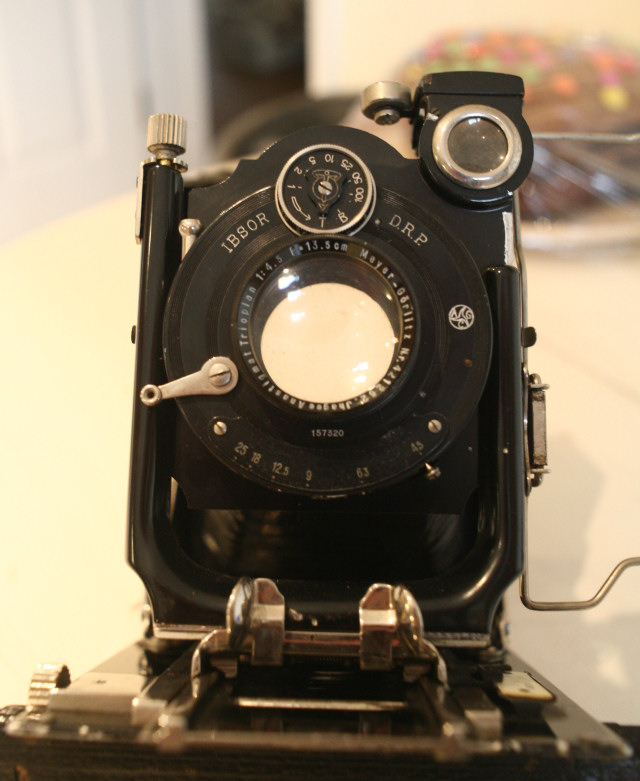
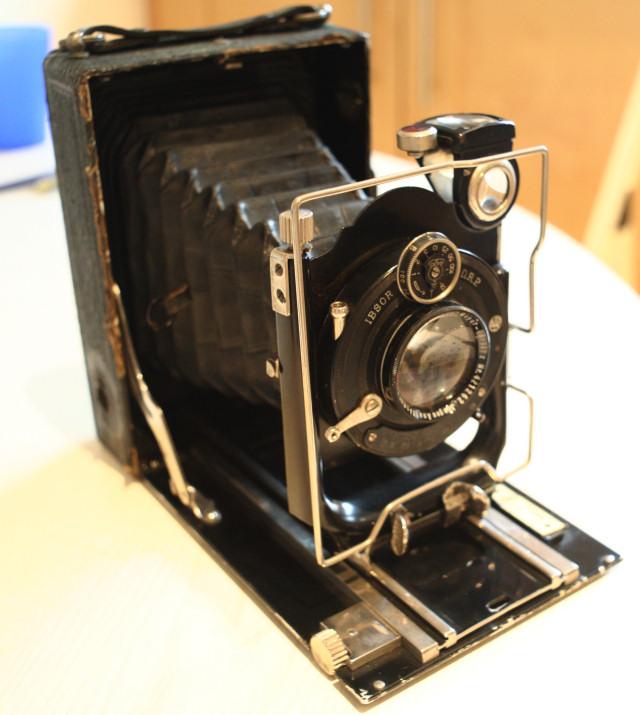
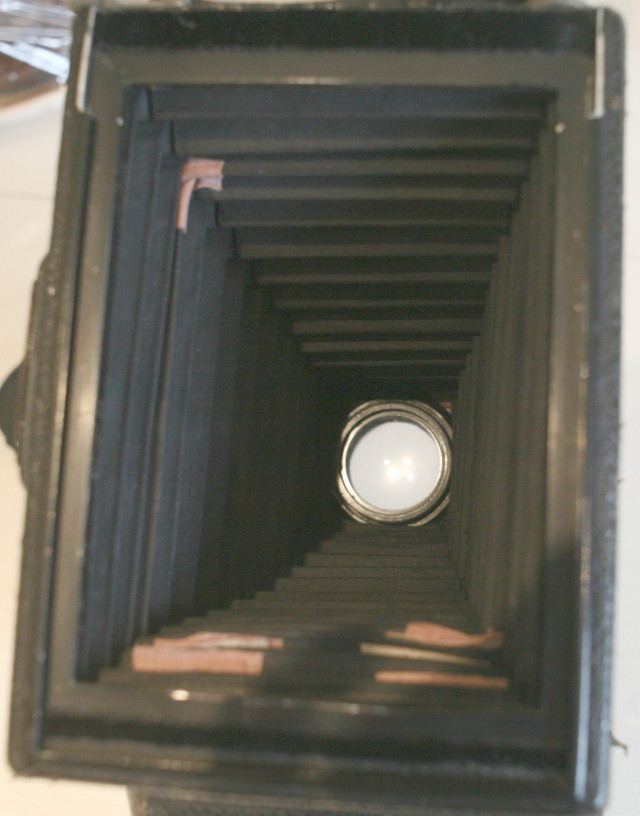
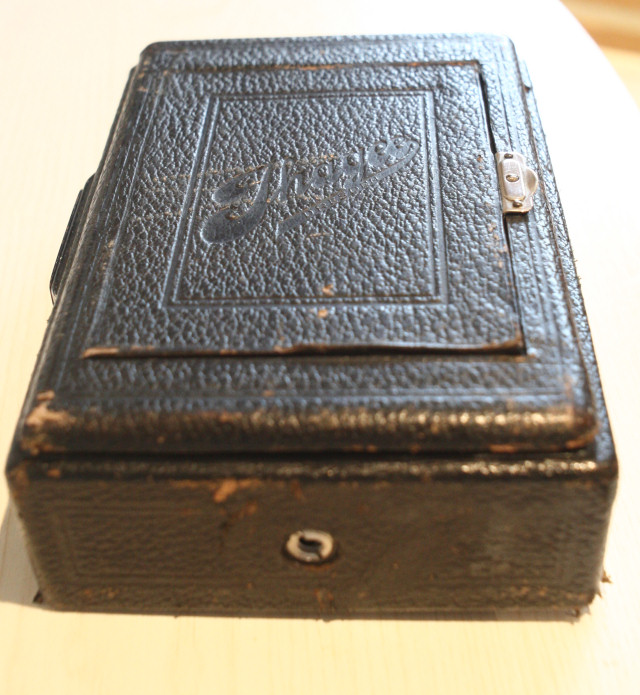
As you can see, body condition is poor, especially the bellows. Anyone know if I can get new bellows anywhere? Also, is the lens removable? If so, how? It could do with a good clean 
I must say I am impressed by the ingenuity of the engineering. It is a plate camera. Did the plates just contain photographic paper? Or was some sort of film used? I would love to get a few snaps through this antique masterpiece.
Also, there is an adjuster which varies the height of the lens in relation to the track it slides on. What is the purpose of this?
I am having trouble tracking down a f4.5 135mm Trioplan lens in the VM, so not sure how common this camera/lens is.
Anyone have any info? |
|
| Back to top |
|
 |
luisalegria


Joined: 07 Mar 2008
Posts: 6602
Location: San Francisco, USA
Expire: 2018-01-18
|
 Posted: Sat Oct 02, 2010 4:03 pm Post subject: Posted: Sat Oct 02, 2010 4:03 pm Post subject: |
 |
|
luisalegria wrote:
Due to a recent spell of insanity, I have acquired about a dozen plate cameras of these types, and have spent most of the last three months messing with them.
Some answers -
- You can remove the lens and shutter. It may or may not be easy. When you collapse the bellows you can get at the usual sort of slotted lock ring on the back of the lens standard (which will be partly covered by the bellows). This can be unscrewed with a spanner, two small screwdrivers, etc, whatever works for you. Sometimes that ring is tight; all the usual remedies apply. Once that is unscrewed the shutter comes right off.
- The Trioplan is very easy to clean. The front and back cells unscrew right off the shutter, and the first cell unscrews also to give access to all surfaces. You can even clean the lens without removing the shutter from the front standard.
- The Ibsor shutter is simple and easy to open, flush-clean and lubricate if necessary.
- Bellows are a bigger problem. The best source would be another 9x12 plate camera. The problem here is that what you have is a tough in-between - its a mid-range model with extra-long double extension (thats what those rings are for, to take up the extra folds so they don't sag), so you will want a donor with double extension, unfortunately the potential donors with good bellows would be just as good or better than what you have, unless you get lucky and find a donor that is otherwise unrepairable but still has good bellows. You could get a lower-end one as a donor but these generally didn't have double extension bellows; you could use this but you wouldn't be restoring your camera to complete original function.
- The Trioplan lens is quite common on mid-range plate cameras of the time. I have a 10.5cm one on a KW Etui. You will find the Trioplan quite often on a high-end Compur shutter also. It was considered a very good lens in its day, if not quite a Tessar.
- The Vertical rise adjustment is for fixing parallax; its useful for architecture photography for instance, to straighten out converging lines. More expensive types also had a shift (horizontal) adjustment.
- These cameras were very versatile as for film. They could take film holders for cut film, glass plate holders, film pack holders, and 120 roll film backs. You can still get 9x12 film and of course 120 film. Glass plates are mostly gone, but I believe you can still get plain glass ones (I don't know if in 9x12) for collodion and other artisan processes. Film packs are of course long gone - the best use for film pack holders is to convert them into groundglass backs for cameras that have lost their original ones.
_________________
I like Pentax DSLR's, Exaktas, M42 bodies of all kinds, strange and cheap Japanese lenses, and am dabbling in medium format/Speed Graphic work. |
|
| Back to top |
|
 |
martyn_bannister


Joined: 23 May 2010
Posts: 1151
|
 Posted: Sat Oct 02, 2010 4:23 pm Post subject: Posted: Sat Oct 02, 2010 4:23 pm Post subject: |
 |
|
martyn_bannister wrote:
| luisalegria wrote: |
Due to a recent spell of insanity, I have acquired about a dozen plate cameras of these types, and have spent most of the last three months messing with them.
|
I'm glad there is someone out there who is almost as mad as I ! 
Many thanks for those comprehensive answers. The camera came with these three holders which, I assume, are for glass plates, because of the springs either side? Perhaps I could put cut film in them?
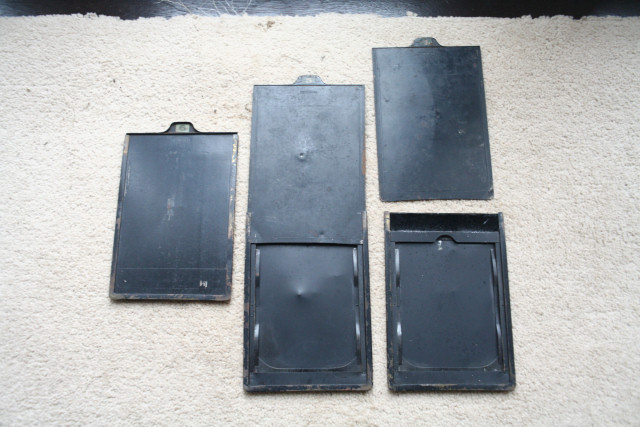
From what you say, cleaning the lens and shutter shouldn't be too difficult. However, I am not going to be able to source a new bellows easily. Any idea what they are made of and how? If one knew the material, perhaps it would be possible to fabricate some anew? |
|
| Back to top |
|
 |
luisalegria


Joined: 07 Mar 2008
Posts: 6602
Location: San Francisco, USA
Expire: 2018-01-18
|
 Posted: Sat Oct 02, 2010 4:38 pm Post subject: Posted: Sat Oct 02, 2010 4:38 pm Post subject: |
 |
|
luisalegria wrote:
Those are glass plate holders. I have a bunch of plate holders in 6.5x9 but I haven't tried to use them.
I understand that you can make them work for film too, you just need to find a flat and rigid material to make a "filler" to back the piece of film or photo paper. I have been thinking of thin plexiglass.
The expensive bellows were made with an outer layer of thin leather backed with fine cloth. The cheaper ones often were coated cloth or patent leather. Some people have used cloth outer covering as well. There are paper inserts sandwiched between the leather and cloth layers to give then their shape. There are several sites with instructions on making bellows; I have tried to do this a couple of times. I haven't found it easy to do. Its doubtless easier to get an acceptable result on a larger format, say for a home-made 4x5 or 8x10 view camera. But this case (very compact double extension) requires a very fine, precise standard of craftsmanship.
_________________
I like Pentax DSLR's, Exaktas, M42 bodies of all kinds, strange and cheap Japanese lenses, and am dabbling in medium format/Speed Graphic work. |
|
| Back to top |
|
 |
estudleon


Joined: 15 May 2008
Posts: 3754
Location: Argentina
|
 Posted: Sat Oct 02, 2010 4:48 pm Post subject: Posted: Sat Oct 02, 2010 4:48 pm Post subject: |
 |
|
estudleon wrote:
Hi Luis.
Thanks. Very informative and instructive words.
NIce to see you again.
Regards, Rino.
_________________
Konica 2,8/100
CZJ: 4/20, 2,4/35, 1,8/50 aus jena, 3,5/135MC, Pentacon 1,8/50
Pentax S-M-C-1,4/50
Helios 44-3
Mamiya 2,8/135
Misc. : jupiter 9
Stuff used:
A) SRL
Alpa 10 D - kern macro Switar 1,9/50 -black, Kilffit apochromat 2/100.
Asahi pentax spotmatic super takumar 1,4/50
Contaflex super B tessar 2,8/50 Pro-tessar 115
Leica R3 electronic summicron 2/50 elmarit 2,8/35
Konica Autoreflex 3 (2 black and chrome one), TC, T4. 2,8/24, 3,5/28 not MC and MC, 1,8/40, 1,4/50, 1,7/50 MC and not MC, 1,8/85, 3,2/135, 3,5/135, 4/200
Minolta XG9 2,8/35, 2/45, 3,5/135
Nikkormat FTn 1,4/50, 2,8/135
Fujica ST 801, 605, 705n. 3,5/19, 1,4/50, 1,8/55, 4/85, 3,5/135.
Praktica MTL 5 and a lot of M42 lenses.
Voigtlander. Bessamatic m, bessamatix de luxe, bessamatic cs, ultramatic and ultramatic cs.
Skoparex 3,5/35, skopagon 2/40, skopar 2,8/50, skopar X 2,8/50, super lanthar (out of catalogue) 2,8/50, dinarex 3,4/90, dinarex 4,8/100, super dinarex 4/135, super dinarex 4/200, zoomar 2,8/36-83, portrait lens 0, 1 and 2. Curtagon 4/28 and 2,8/35
Canon AV1, 1,8/50
Rolleiflex SL35 and SL35 E. 2,8/35 angulon, 2,8/35 distagon, 1,4/55 rolleinar, 1,8/50 planar, 4/135 tessar, 2,8/135 rolleinar, x2 rollei, M42 to rollei adap.
Etc.
RF
Yashica Minister III
Voightlander Vito, vitomatic I, Vito C, etc.
Leica M. M2, M3 (d.s.) and M4. Schenider 3,4/21, 2/35 summaron 2,8/35 (with eyes). Summicron 2/35 (8 elements with eyes), 2/35 chrome, 2/35 black, 1,4/35 pre asph and aspheric - old -, 2/40 summicron, 2,8/50 elmar, 2/50 7 elements, 2/50 DR, 2/50 - minolta version, 1,4/50 summilux 1966 version, 1,4/75 summilux, 2/90 large version, 2/90 reduced version of 1987, 2,8/90 elmarit large version, 4/135 elmar. |
|
| Back to top |
|
 |
luisalegria


Joined: 07 Mar 2008
Posts: 6602
Location: San Francisco, USA
Expire: 2018-01-18
|
 Posted: Sat Oct 02, 2010 5:11 pm Post subject: Posted: Sat Oct 02, 2010 5:11 pm Post subject: |
 |
|
luisalegria wrote:
Hola Rino !
Como va ?
_________________
I like Pentax DSLR's, Exaktas, M42 bodies of all kinds, strange and cheap Japanese lenses, and am dabbling in medium format/Speed Graphic work. |
|
| Back to top |
|
 |
martyn_bannister


Joined: 23 May 2010
Posts: 1151
|
 Posted: Sat Oct 02, 2010 5:31 pm Post subject: Posted: Sat Oct 02, 2010 5:31 pm Post subject: |
 |
|
martyn_bannister wrote:
| luisalegria wrote: |
Those are glass plate holders. I have a bunch of plate holders in 6.5x9 but I haven't tried to use them.
|
Hmmm.... these seem to be 8cm x 10cm for the glass which would fit inside. Is this a standard size? I can't find reference to it. |
|
| Back to top |
|
 |
martyn_bannister


Joined: 23 May 2010
Posts: 1151
|
 Posted: Sat Oct 02, 2010 5:34 pm Post subject: Posted: Sat Oct 02, 2010 5:34 pm Post subject: |
 |
|
martyn_bannister wrote:
| luisalegria wrote: |
The expensive bellows were made with an outer layer of thin leather backed with fine cloth. The cheaper ones often were coated cloth or patent leather. Some people have used cloth outer covering as well. There are paper inserts sandwiched between the leather and cloth layers to give then their shape. There are several sites with instructions on making bellows; I have tried to do this a couple of times. I haven't found it easy to do. Its doubtless easier to get an acceptable result on a larger format, say for a home-made 4x5 or 8x10 view camera. But this case (very compact double extension) requires a very fine, precise standard of craftsmanship. |
That rules me out then 
Yes, I have found a couple of sites and it does look difficult! Perhaps I'll just renew the elastoplast  |
|
| Back to top |
|
 |
luisalegria


Joined: 07 Mar 2008
Posts: 6602
Location: San Francisco, USA
Expire: 2018-01-18
|
 Posted: Sat Oct 02, 2010 6:05 pm Post subject: Posted: Sat Oct 02, 2010 6:05 pm Post subject: |
 |
|
luisalegria wrote:
That would be 9x12 plates, even if the size isn't quite that. I would look for a "9x12" label if I were looking for old plates.
I am guessing though that if you want to try your hand at real glass plate photography you would have to have glass cut to size.
_________________
I like Pentax DSLR's, Exaktas, M42 bodies of all kinds, strange and cheap Japanese lenses, and am dabbling in medium format/Speed Graphic work. |
|
| Back to top |
|
 |
Sevo

Joined: 22 Aug 2008
Posts: 1189
Location: Frankfurt, Germany
Expire: 2012-12-03
|
 Posted: Sat Oct 02, 2010 6:06 pm Post subject: Posted: Sat Oct 02, 2010 6:06 pm Post subject: |
 |
|
Sevo wrote:
| martyn_bannister wrote: |
Hmmm.... these seem to be 8cm x 10cm for the glass which would fit inside. Is this a standard size? I can't find reference to it. |
That would be quarter plate - 83x105mm. The 135mm lens points to that as well, it is wide by 9x12 standards of the time and a triplet would be too short to cover 9x12 with movements, but 135mm was the normal length for quarter plate. Bad news: While Ilford do occasionally cut QP film, the film choice for this camera will be very limited and it will be available only on pre-order once each year. You'd better learn to cut down your own from 9x12 or 4x5 sheets.
Sevo
_________________
Sevo |
|
| Back to top |
|
 |
martyn_bannister


Joined: 23 May 2010
Posts: 1151
|
 Posted: Sat Oct 02, 2010 6:14 pm Post subject: Posted: Sat Oct 02, 2010 6:14 pm Post subject: |
 |
|
martyn_bannister wrote:
| Sevo wrote: |
| martyn_bannister wrote: |
Hmmm.... these seem to be 8cm x 10cm for the glass which would fit inside. Is this a standard size? I can't find reference to it. |
That would be quarter plate - 83x105mm. The 135mm lens points to that as well, it is wide by 9x12 standards of the time and a triplet would be too short to cover 9x12 with movements, but 135mm was the normal length for quarter plate. Bad news: While Ilford do occasionally cut QP film, the film choice for this camera will be very limited and it will be available only on pre-order once each year. You'd better learn to cut down your own from 9x12 or 4x5 sheets.
Sevo |
Thanks for that info. It has to be film, or glass, right? I couldn't use paper, because paper is designed to be used with a negative? |
|
| Back to top |
|
 |
Sevo

Joined: 22 Aug 2008
Posts: 1189
Location: Frankfurt, Germany
Expire: 2012-12-03
|
 Posted: Sat Oct 02, 2010 6:43 pm Post subject: Posted: Sat Oct 02, 2010 6:43 pm Post subject: |
 |
|
Sevo wrote:
Paper has sensitivities in the 1 ISO range, and blue only spectral sensitivity - with that, paper will do as a nice substitute for mid 19th century processes, but hardly for modern film.
What you have are plate holders - to put film or paper in there, you'd need folded metal sheaths. These actually are not rare, and even exist as format adapters (e.g. 6.5x9 film inside a quarter plate holder), but they usually have been separated from the holders, making it hard to identify fitting ones - even more so as most sellers are ignorant and seem to be unable to give accurate dimensions even on request. But sometimes there are identifiable ones on sale, I just got me seven 6.5x9 ones at 1.5€ each on ebay last week. At a pinch you can also fill the gap with cardboard or a thin glass plate.
Sevo
_________________
Sevo
Last edited by Sevo on Sat Oct 02, 2010 8:38 pm; edited 1 time in total |
|
| Back to top |
|
 |
luisalegria


Joined: 07 Mar 2008
Posts: 6602
Location: San Francisco, USA
Expire: 2018-01-18
|
 Posted: Sat Oct 02, 2010 6:46 pm Post subject: Posted: Sat Oct 02, 2010 6:46 pm Post subject: |
 |
|
luisalegria wrote:
You can absolutely use photo printing paper.
I use it quite a lot in 4x5 film holders.
Just cut sheets to size under a safelight (a dim incandescent with orange/red filter) and load in the film holders.
Expose it at ISO 6
Is easy to develop under a safelight too.
Its also easy to scan on a standard scanner, you don't need a 4x5 negative scanner.
_________________
I like Pentax DSLR's, Exaktas, M42 bodies of all kinds, strange and cheap Japanese lenses, and am dabbling in medium format/Speed Graphic work. |
|
| Back to top |
|
 |
martyn_bannister


Joined: 23 May 2010
Posts: 1151
|
 Posted: Sat Oct 02, 2010 7:20 pm Post subject: Posted: Sat Oct 02, 2010 7:20 pm Post subject: |
 |
|
martyn_bannister wrote:
Thanks to you both for this info. Sounds like a really interesting project. I've just been looking for paper and chemicals and found that there is a bewildering array of stuff. Can anyone recommend a supplier in the UK?
I can;t belive I'm even considering going back to using <gasp> a film camera  |
|
| Back to top |
|
 |
kansalliskala


Joined: 19 Jul 2007
Posts: 5044
Location: Southern Finland countryside
Expire: 2016-12-30
|
 Posted: Sat Oct 02, 2010 7:24 pm Post subject: Posted: Sat Oct 02, 2010 7:24 pm Post subject: |
 |
|
kansalliskala wrote:
| luisalegria wrote: |
| - These cameras were very versatile as for film. They could take film holders for cut film, glass plate holders, film pack holders, and 120 roll film backs. You can still get 9x12 film and of course 120 film. Glass plates are mostly gone, but I believe you can still get plain glass ones (I don't know if in 9x12) for collodion and other artisan processes. Film packs are of course long gone - the best use for film pack holders is to convert them into groundglass backs for cameras that have lost their original ones. |
And possibly polaroid? Don't know excactly what pack they take but 100 series Fuji FP100 is still available and maybe some others vie impossible project?
_________________
MF: Kodak DCS SLR/c; Samsung NX10; OM-10; Canon T50
Zuiko 28/3.5, Distagon 35/2.8; Yashica ML 50/2;
Zuiko 50/1.4; S-M-C 120/2.8; Zuiko 135/3.5; 200/5;
Tamron AD1 135/2.8, Soligor 180/3.5; Tamron AD1 300/5.6
Tamron zooms: 01A, Z-210
Yashicaflex C; Київ 4 + Юпитер 8, 11; Polaroid 100; Olympus XA; Yashica T3
Museum stuff: Certo-Phot; Tele-Edixon 135; Polaris 90-190; Asahi Bellows; Ixus IIs
Projects: Agfa Isolette III (no shutter), Canon AE-1D (no sensor),
Nikon D80 (dead), The "Peace Camera"
AF: Canon, Tokina, Sigma Video: JVC GZ-MG275E |
|
| Back to top |
|
 |
luisalegria


Joined: 07 Mar 2008
Posts: 6602
Location: San Francisco, USA
Expire: 2018-01-18
|
 Posted: Sat Oct 02, 2010 7:40 pm Post subject: Posted: Sat Oct 02, 2010 7:40 pm Post subject: |
 |
|
luisalegria wrote:
I'm sure you could make an adapter for a Polaroid pack film holder. The format of these should fit a 9x12 camera. Maybe thats a good use for one of the very common and otherwise useless 9x12 pack film holders, mate one of those with the Polaroid back.
You will need to make a dedicated groundglass back to use to focus for the Polaroid I think, as I don't think you could make the film plane on the Polaroid holder mount flush with the original groundglass. Thats another use for pack film holders, just figure out the depth of spacer you need inside it to match the Polaroid back plus adapter.
_________________
I like Pentax DSLR's, Exaktas, M42 bodies of all kinds, strange and cheap Japanese lenses, and am dabbling in medium format/Speed Graphic work. |
|
| Back to top |
|
 |
PeteMarshall

Joined: 04 Oct 2010
Posts: 1
|
 Posted: Mon Oct 04, 2010 3:30 pm Post subject: Posted: Mon Oct 04, 2010 3:30 pm Post subject: |
 |
|
PeteMarshall wrote:
| martyn_bannister wrote: |
Thanks to you both for this info. Sounds like a really interesting project. I've just been looking for paper and chemicals and found that there is a bewildering array of stuff. Can anyone recommend a supplier in the UK?
I can;t belive I'm even considering going back to using <gasp> a film camera  |
seems bb links, whilst showing correctly in preview don't work when posted....the site you want is Silverprint
A bit of chipboard, a C type adapter and a Panasonic GF-1 would make a fine digital back for this camera if you really don't want to use film. |
|
| Back to top |
|
 |
lens-o-matic

Joined: 05 Sep 2009
Posts: 54
|
 Posted: Sun Oct 17, 2010 1:00 pm Post subject: Posted: Sun Oct 17, 2010 1:00 pm Post subject: |
 |
|
lens-o-matic wrote:
+1 to the idea of using a dslr as the "Film Back".
I have been working on a project with a fairly rotten Goerz lens, similar to what you have there.
I was able to disassemble the camera (the lens screwed off from behind, but I had to make a tool).
My lens has visible defects that I cannot clean off, makes a horrible cloud in most images, and is the most interesting photo project I have had all year. It's been my primary lens for 2 weeks now, and I have really been having a lot of fun while learning.
I have a photoblog:
http://photopictomania.blogspot.com/
where I have been putting up the results of my endevours.
I had a few different attempts at mounting. The most satisfactory version involved taping the lens to an M42 extension tube and mounting the tube on a M42 bellows.
Good luck, please post photos to show how you get on! |
|
| Back to top |
|
 |
martyn_bannister


Joined: 23 May 2010
Posts: 1151
|
 Posted: Sun Oct 17, 2010 2:41 pm Post subject: Posted: Sun Oct 17, 2010 2:41 pm Post subject: |
 |
|
martyn_bannister wrote:
| lens-o-matic wrote: |
+1 to the idea of using a dslr as the "Film Back".
I have been working on a project with a fairly rotten Goerz lens, similar to what you have there.
I was able to disassemble the camera (the lens screwed off from behind, but I had to make a tool).
My lens has visible defects that I cannot clean off, makes a horrible cloud in most images, and is the most interesting photo project I have had all year. It's been my primary lens for 2 weeks now, and I have really been having a lot of fun while learning.
I have a photoblog:
http://photopictomania.blogspot.com/
where I have been putting up the results of my endevours.
I had a few different attempts at mounting. The most satisfactory version involved taping the lens to an M42 extension tube and mounting the tube on a M42 bellows.
Good luck, please post photos to show how you get on! |
That is one interesting blog and some very nice images. Thanks for sharing. Inspiration indeed  |
|
| Back to top |
|
 |
woodrim


Joined: 14 Jan 2010
Posts: 4060
Location: Charleston
|
 Posted: Sun Oct 17, 2010 4:25 pm Post subject: Posted: Sun Oct 17, 2010 4:25 pm Post subject: |
 |
|
woodrim wrote:
Mertyn: I hope you don't mind me adding a picture of another such camera to your post. Your initial post caused me to go find this one that I've had for a few decades sitting unused - and never used by me. I doubt it's worth much. No lens data; safe to assume it is a Kodak lens. Does yours have a patent date?
I find it very interesting the notion of somehow combining this old photo technology with today's digital, but I can't energize any interest in myself to bother with film of any type. However, I keep asking why. Why bother using such an old and presumable inferior lens? I think I can answer that from my own perspective, but I wonder how you and Luis and lens-o-matic would answer it.
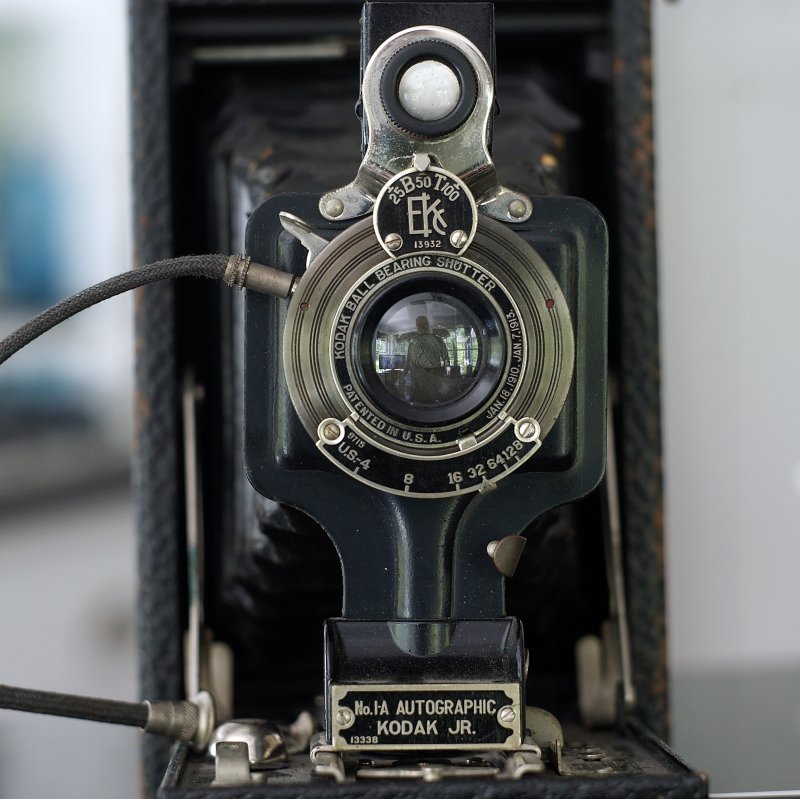
_________________
Regards,
Woodrim |
|
| Back to top |
|
 |
martyn_bannister


Joined: 23 May 2010
Posts: 1151
|
 Posted: Sun Oct 17, 2010 4:47 pm Post subject: Posted: Sun Oct 17, 2010 4:47 pm Post subject: |
 |
|
martyn_bannister wrote:
| woodrim wrote: |
Mertyn: I hope you don't mind me adding a picture of another such camera to your post. Your initial post caused me to go find this one that I've had for a few decades sitting unused - and never used by me. I doubt it's worth much. No lens data; safe to assume it is a Kodak lens. Does yours have a patent date?
I find it very interesting the notion of somehow combining this old photo technology with today's digital, but I can't energize any interest in myself to bother with film of any type. However, I keep asking why. Why bother using such an old and presumable inferior lens? I think I can answer that from my own perspective, but I wonder how you and Luis and lens-o-matic would answer it.
|
Nice camera Mike.
Why would I bother? Just for the sake of doing it I suppose  The thing that really sets film apart from digital (for me) is the instant results. The thing that really sets film apart from digital (for me) is the instant results.
Sure, it would be great fun to use proper film or paper in such a camera and perhaps appreciate the results more because of the effort involved, but for a couple of hours playing with gaffa tape, a sheet of tin and an adapter, I think the "digital back" is just a fun idea  |
|
| Back to top |
|
 |
woodrim


Joined: 14 Jan 2010
Posts: 4060
Location: Charleston
|
 Posted: Tue Oct 19, 2010 2:43 pm Post subject: Posted: Tue Oct 19, 2010 2:43 pm Post subject: |
 |
|
woodrim wrote:
I found the lens identification - it was marked on the side. It's a Rapid Rectilinear Bausch & Lomb Co. Didn't see anything about focal length. f/4 as can be seen on the front.
lens-o-matic: I enjoyed your blog. Can you say more about the method of mounting the digital camera on the back of the folding camera? I don't really want to take the lens off this one as it doesn't appear straight forward and I also don't want to destroy this old piece of photographic history. When you tried this first method, how did you deal with the increased registration distance? Is it just a matter of collapsing the bellows?
I've actually taken a few pictures through it by using a macro lens. Not great, but better than I might have expected.
_________________
Regards,
Woodrim |
|
| Back to top |
|
 |
dof


Joined: 04 Feb 2009
Posts: 339
Location: Southern California
|
 Posted: Tue Oct 19, 2010 4:14 pm Post subject: Posted: Tue Oct 19, 2010 4:14 pm Post subject: |
 |
|
dof wrote:
Since we're showing off our plate cameras, this is my 9x12 Nagel Kodak
Recomar 33 with 135/4.5 Kodak Anastigmat lens. I found it at a flea market
for $15. I've done a bit of restoration and everything seems to work. I just
got some film holders for it and now just need to replace the ground glass
before testing.

Freestyle sells one 9x12 film and you can get Ilford films in that size from
European suppliers but it's pricey. I will probably just use cut-down 4x5 film. |
|
| Back to top |
|
 |
martyn_bannister


Joined: 23 May 2010
Posts: 1151
|
 Posted: Tue Oct 19, 2010 4:47 pm Post subject: Posted: Tue Oct 19, 2010 4:47 pm Post subject: |
 |
|
martyn_bannister wrote:
Nice camera - and the bellows look in vey good conditions. Looking forward to show example shots  |
|
| Back to top |
|
 |
|
|
